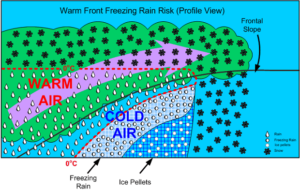
The weather this past week in Madison has been very interesting.
On at least three occasions we experienced a mix of precipitation types — with snow, hail, graupel and rain in various combinations.
Early in the week the precipitation was delivered by the passage of a mid-latitude cyclone. These disturbances are organized on very large scales and have a characteristic distribution of clouds and precipitation associated with them. The early week precipitation was most closely tied to the passage of the cold frontal portion of the larger cyclone.
By the nature of their large-scale structure, such storms usually have a region of quite cold air at about 3 miles above the surface trailing to their west and northwest. When this air moves over a given location, the temperature difference between the surface and 3 miles above the surface naturally increases. This increased temperature difference reduces the resistance air parcels have to move in the vertical direction. Since this usually substantial resistance is lessened in such cases, upward vertical motions (which produce cloud and precipitation) are more easily generated.
The widespread, but intermittent, snow and graupel over southern Wisconsin on Saturday was largely a consequence of this set of physical circumstances. The fact that the showers abruptly ceased after sunset is another characteristic of this kind of precipitation generation mechanism in action.
Since April, as we all know, is still capable of delivering pretty cold temperatures, it turns out that a large fraction of this month’s fabled April showers are produced in exactly this manner.
Steve Ackerman and Jonathan Martin, professors in the UW-Madison department of atmospheric and oceanic sciences, are guests on WHA radio (970 AM) at 11:45 a.m. the last Monday of each month. Send them your questions at stevea@ssec.wisc.edu or jemarti1@wisc.edu.

